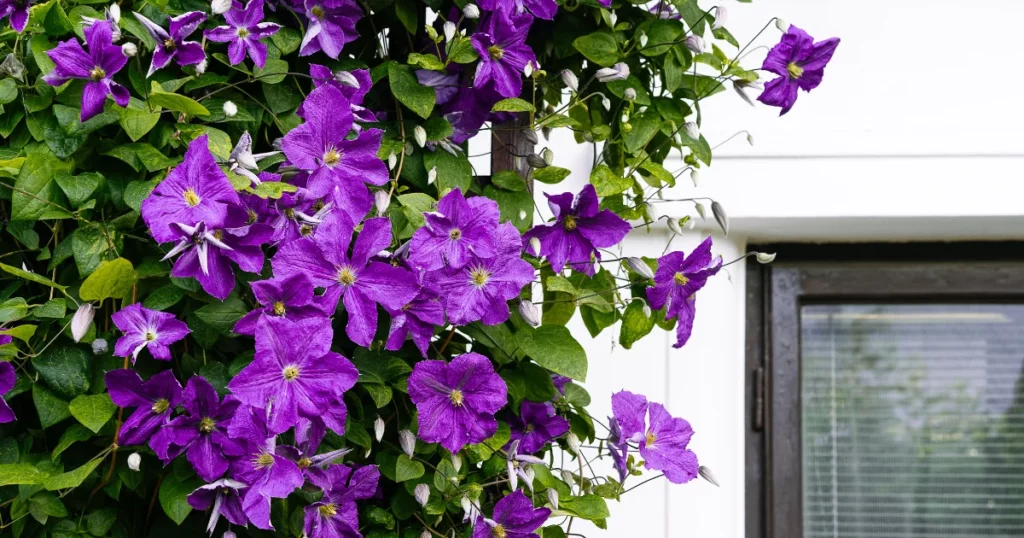Overview of Purple Flower Vines
Purple flower vines are a beautiful and diverse group of climbing plants that add a touch of elegance and color to gardens and landscapes. These vines are known for their vibrant purple blooms that can range from deep, rich hues to delicate lavender shades. One notable example of a purple flower vine is the Wisteria (Wisteria spp.). Wisterias are beloved for their cascading clusters of fragrant flowers that bloom in spring, creating a stunning display. This article will explore the characteristics, cultivation, uses, and cultural significance of wisteria, along with a comprehensive FAQ section.
Characteristics of Wisteria
Botanical Description
- Scientific Name: Wisteria spp.
- Family: Fabaceae (Legume family)
- Common Names: Wisteria, Wistaria
Physical Appearance
- Vine: Wisteria is a deciduous, woody vine that can grow up to 30 meters (98 feet) long.
- Leaves: The leaves are pinnately compound, consisting of 9 to 19 leaflets that are dark green in color.
- Flowers: Wisteria produces clusters of pea-like flowers that bloom in spring. The flowers can be purple, blue, white, or pink, depending on the species and cultivar.
- Seed Pods: After flowering, wisteria produces long, bean-like seed pods that turn brown as they mature.
Cultivation and Care
Growing Conditions
Wisteria prefers well-drained, moist soil and full sun to partial shade. It thrives in USDA hardiness zones 5-9.
Planting and Support
When planting wisteria, provide a sturdy support structure, such as a trellis, arbor, or pergola, for the vine to climb. Space plants 10 to 15 feet apart.
Pruning and Training
Regular pruning is essential to maintain the shape and size of the wisteria vine. Prune in late winter or early spring before new growth appears.
Propagation
Wisteria can be propagated through seeds, cuttings, or grafting. Seeds should be scarified before planting to improve germination.
Uses of Wisteria
Ornamental
Wisteria is primarily grown for its stunning floral displays and is a popular choice for arbors, pergolas, and trellises in gardens and landscapes.
Culinary
The young seed pods and flowers of some wisteria species are edible and can be used in salads, stir-fries, or tempura.
Traditional Medicine
In traditional Chinese medicine, wisteria has been used to treat various ailments, such as headaches, joint pain, and inflammation.
Cultural Significance
Japan
Wisteria is a beloved symbol in Japanese culture, often featured in art, literature, and festivals. The Ashikaga Flower Park in Japan is famous for its stunning wisteria displays.
United States
Wisteria was introduced to the United States in the early 19th century and has since become a popular ornamental plant, particularly in the southern states.
Potential Invasiveness
It’s important to note that some wisteria species, such as the Chinese Wisteria (Wisteria sinensis) and Japanese Wisteria (Wisteria floribunda), can be invasive in certain regions. These species can quickly spread and outcompete native plants. It’s crucial to research the specific species and cultivars before planting and to remove any volunteer seedlings promptly.
Table of Key Information
| Common Name | Scientific Name | Flower Color | Hardiness Zones | Native Region |
|---|---|---|---|---|
| Wisteria | Wisteria spp. | Purple, blue, white, pink | 5-9 (USDA) | China, Japan, United States |
Frequently Asked Questions (FAQ)
1. What is wisteria?
Wisteria is a genus of flowering vines in the pea family (Fabaceae) known for their cascading clusters of fragrant purple, blue, white, or pink flowers.
2. Where does wisteria grow best?
Wisteria thrives in well-drained, moist soil and full sun to partial shade. It is hardy in USDA zones 5-9.
3. How do I plant and support a wisteria vine?
Plant wisteria near a sturdy support structure, such as a trellis or arbor, and space plants 10 to 15 feet apart. Provide a support for the vine to climb.
4. When does wisteria bloom?
Wisteria typically blooms in spring, producing cascading clusters of fragrant flowers.
5. How do I prune and train wisteria?
Prune wisteria in late winter or early spring before new growth appears. Regular pruning helps maintain the shape and size of the vine.
6. Can I eat wisteria flowers and pods?
Yes, the young seed pods and flowers of some wisteria species are edible and can be used in salads, stir-fries, or tempura.
7. Is wisteria invasive?
Some wisteria species, such as Chinese Wisteria and Japanese Wisteria, can be invasive in certain regions. Research the specific cultivar before planting and remove volunteer seedlings promptly.
8. What is the cultural significance of wisteria?
Wisteria is a beloved symbol in Japanese culture and is often featured in art, literature, and festivals. It was introduced to the United States in the early 19th century and has since become a popular ornamental plant.
9. How do I propagate wisteria?
Wisteria can be propagated through seeds, cuttings, or grafting. Seeds should be scarified before planting to improve germination.
10. Are there any medicinal uses for wisteria?
In traditional Chinese medicine, wisteria has been used to treat various ailments, such as headaches, joint pain, and inflammation.
Conclusion
Wisteria is a stunning and versatile purple flower vine that adds beauty and fragrance to gardens and landscapes. Its cultural significance and ornamental value make it a beloved plant in many regions. By understanding its characteristics, cultivation requirements, and potential invasiveness, gardeners can enjoy the beauty of wisteria while promoting responsible stewardship of the environment.For further detailed information, you can refer to the Wikipedia page on Wisteria.

Leave a Reply